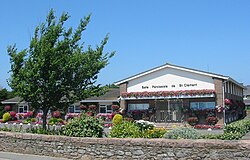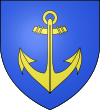Saint Clement, Jersey
| Saint Clement | ||
|---|---|---|
| Jersey parish | ||

The Parish Hall of St. Clement at Le Hocq is the most modern of the island's parish halls
|
||
|
||
 Location of Saint Clement in Jersey |
||
| Crown Dependency | Jersey, Channel Islands | |
| Government | ||
| • Connétable | Leonard Norman | |
| Area | ||
| • Total | 4.2 km2 (1.6 sq mi) | |
| Area rank | Ranked 12th | |
| Population (2011) | ||
| • Total | 9,221 | |
| • Density | 2,200/km2 (5,700/sq mi) | |
| Time zone | GMT | |
| • Summer (DST) | UTC+01 (UTC) | |
| Postcode district | JE2 | |
| Postcode sector | 6 | |
| Website | www |
|
Saint Clement (Jèrriais: St Cliément) is one of the twelve parishes of Jersey in the Channel Islands. It is in the south east of the Island, and contains some of the suburbs of Saint Helier. It is the smallest parish by surface area, but the second most densely populated. St. Clement stretches west to east from Le Dicq to within a quarter mile of La Rocque harbour (at the end of Rue de la Lourderie). Its surface area is around 1,044 acres (4.22 km2).
The parish is subdivided into three vingtaines, and is administered at local level by the Connétable.
Much of the parish lies below equinoctial high-tide level and was frequently flooded before Le Dicq was built to try to hold back the sea somewhat. There are remains of a submerged forest underneath the sand at Grève d'Azette that show how the parish has reduced in size as the sea has advanced. Large floods in 1688, 1796 and 1812 led to the coast road at Le Hocq being swept away by the sea and necessitated the coast road being rebuilt further inland.
In pre-Norman times, the area now known as St. Clement was known as Petravilla or Pierreville. In 1172 it was recorded that a chapel existed in the parish, and there was a priory on the site of the old Priory Inn (now houses).
In the 16th and 17th centuries the parish was believed to be the centre of a witch movement. According to beliefs, the rock at Rocque Berg (known as the Witches' Rock) was the focus for witchcraft in Jersey and witches would assemble there for their sabbats on Friday nights.
After the revocation of the Edict of Nantes in 1685, many French Protestants settled in the parish – as recorded on the church register.
In the mid 19th century, the town began to spread east from St. Helier into the west of the parish. Today there is relatively little open green space (with the exception of the golf and football fields) west of Samarès Lane into St. Helier.
The famous French writer Victor Hugo lived in Marina Terrace, St. Clement for some time, and it was here that he wrote his collection of poems entitled Les Châtiments. It was the Connétable of St. Clement at the time who escorted Hugo onto a steamer bound for Guernsey when he had insulted the British Royal Family in some of his letters.
...
Wikipedia

